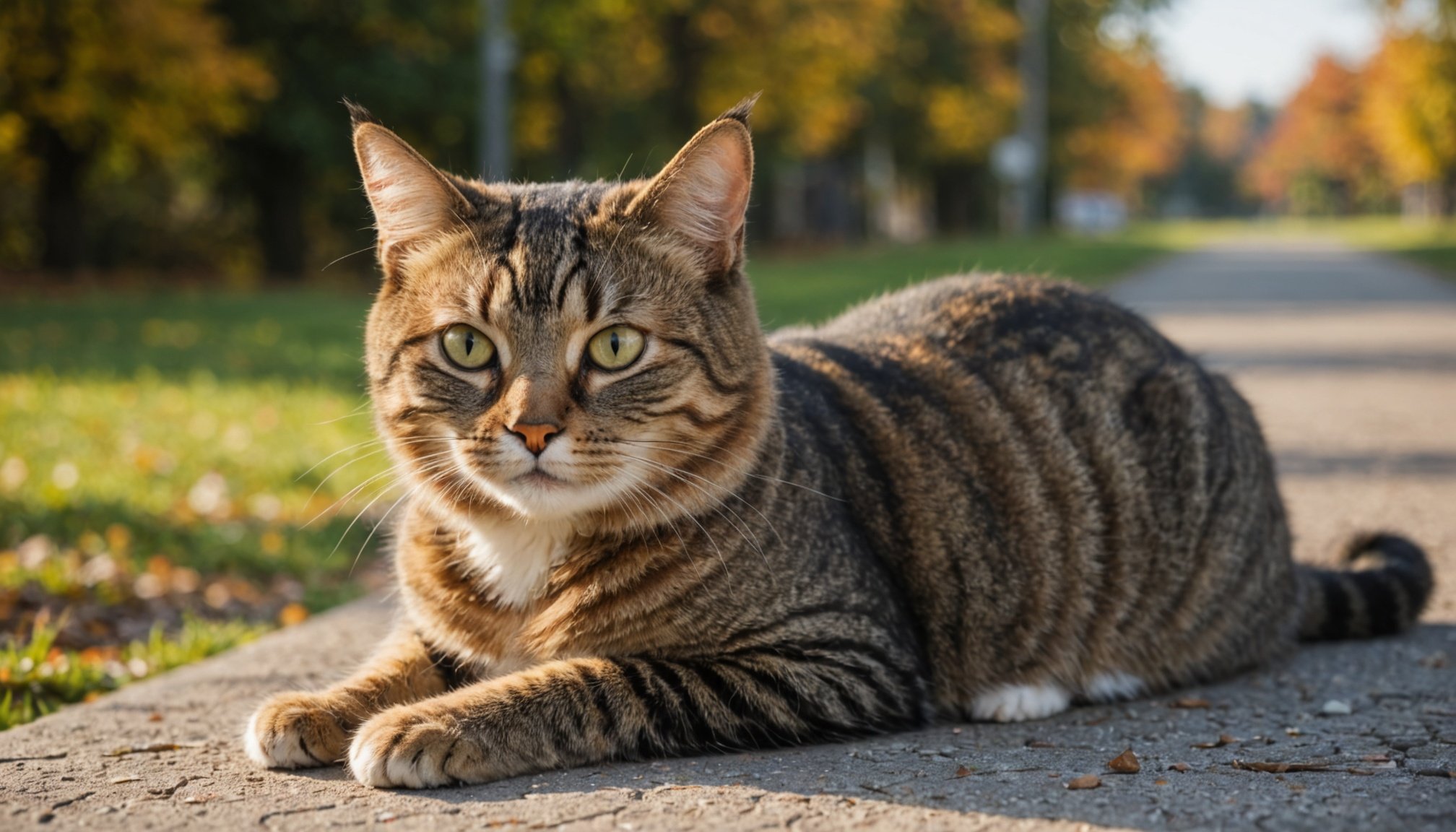Uncovering and Alleviating Environmental Stressors in Cats to Prevent Psychosomatic Issues
Understanding Cat Stress and Its Implications
When we think about our feline friends, we often picture them as calm and serene creatures, but the truth is, cats can be just as prone to stress as any other animal. Stress in cats can manifest in various ways, from behavioral changes to physical health issues, and it is crucial to identify and address these stressors to ensure the well-being of our feline companions.
Signs of Stress in Cats
Recognizing the signs of stress in cats is the first step towards helping them. Here are some common indicators:
A voir aussi : Boosting UK Biodiversity: The Impact of Creating Your Own Butterfly Garden
- Changes in Appetite: A stressed cat may show a decrease or increase in appetite.
- Altered Sleep Patterns: Stress can lead to changes in sleep habits, such as sleeping more or less than usual.
- Increased Grooming: Excessive grooming can be a sign of anxiety or stress.
- Urinary Issues: Stress can cause cats to avoid the litter box or develop urinary tract problems.
- Aggression or Withdrawal: Stressed cats may become more aggressive or withdrawn.
- Vocalization: Increased meowing or other vocalizations can indicate stress.
| Signs of Stress | Description |
|
|-----------------------------------------------------------------------------|
| Changes in Appetite | Decrease or increase in food intake |
| Altered Sleep Patterns | Sleeping more or less than usual |
| Increased Grooming | Excessive grooming |
| Urinary Issues | Avoiding the litter box or urinary tract problems |
| Aggression or Withdrawal | Becoming more aggressive or withdrawn |
| Vocalization | Increased meowing or other vocalizations |
Environmental Enrichment: A Key to Reducing Stress
Environmental enrichment is a critical concept in reducing stress and improving the overall well-being of cats. This involves creating a stimulating and comfortable environment that caters to a cat’s natural behaviors and needs.
Types of Environmental Enrichment
There are several types of environmental enrichment that can be implemented to help reduce stress in cats:
Sujet a lire : Boosting UK Biodiversity: The Impact of Creating Your Own Butterfly Garden
-
Physical Enrichment:
-
Providing climbing structures, scratching posts, and interactive toys to encourage physical activity and exercise[4].
-
Sensory Enrichment:
-
Engaging a cat’s senses through different scents, sounds, and textures. For example, introducing new smells or auditory stimuli can keep the environment intriguing and prevent boredom[4].
-
Social Enrichment:
-
Regular interaction with humans and other animals. This can improve a cat’s social skills and adaptability, especially for cats that may be shy or withdrawn[4].
Practical Strategies for Reducing Stress
Implementing the right strategies can make a significant difference in reducing stress in cats. Here are some practical tips:
Interactive Play and Toys
Interactive play is essential for mental stimulation and physical exercise. Using toys that mimic prey, such as feather wands or laser pointers, can encourage natural hunting behaviors and keep your cat engaged.
Safe Hiding Spots
Providing safe hiding spots, such as cardboard boxes or tunnels, can help your cat feel secure and reduce anxiety.
Sensory Stimulation
Offering different textures, smells, and sounds can keep your cat’s environment interesting. For example, you can introduce new catnip toys or scratching pads with different textures.
Regular Routine
Maintaining a regular routine for feeding, playtime, and sleep can provide a sense of stability and reduce stress.
The Role of Human Interaction
Human interaction plays a vital role in the mental and emotional well-being of cats. Here’s how you can help:
Quality Time
Spend quality time with your cat, engaging in activities that they enjoy, such as petting, grooming, or simply sitting together.
Positive Reinforcement
Use positive reinforcement techniques, such as food treats, to encourage good behavior and strengthen the bond between you and your cat.
Observation and Response
Observe your cat’s behavior and respond accordingly. If you notice signs of stress, try to identify the cause and take steps to alleviate it.
The Impact of Stress on Health
Stress can have severe implications on a cat’s health, both physically and mentally.
Physical Health
Chronic stress can lead to physical health issues such as obesity, urinary tract problems, and a weakened immune system. Regular exercise and a balanced diet are crucial in maintaining physical health, but stress can disrupt these routines[4].
Mental Health
Stress can exacerbate mental health issues such as anxiety and depression. Cats under stress may exhibit behavioral problems, such as increased aggression or withdrawal, which can further complicate their mental health[3].
Data Collection and Scholarly Insights
Research and data collection are essential in understanding the effects of stress on cats and developing effective strategies to alleviate it.
Studies on Cat Stress
Several studies have highlighted the importance of environmental enrichment and human interaction in reducing stress in cats. For example, a study published on Google Scholar emphasized the role of interactive play and sensory stimulation in mitigating stress-related behaviors in cats[4].
Scholarly Recommendations
Scholars recommend a multi-faceted approach to reducing stress in cats, including physical, sensory, and social enrichment. Dr. Laurie Brush, founder of Heaven at Home Pet Hospice, notes, “Ensuring support for pet care during stressful periods is vital for both the companion animal and his or her human counterpart”[1].
Real-Life Examples and Anecdotes
Understanding how real cat owners have managed to reduce stress in their pets can provide valuable insights.
A Personal Story
One cat owner, Sarah, noticed that her cat, Max, was becoming increasingly stressed due to changes in their home environment. She introduced interactive toys and created safe hiding spots, which significantly reduced Max’s stress levels. Sarah also made sure to spend quality time with Max, engaging in activities that he enjoyed, such as playing with feather wands. and Actionable Advice
Reducing stress in cats is a multifaceted task that requires attention to their environment, behavior, and interaction with humans. Here are some actionable tips to help you alleviate stress in your feline companion:
- Create a Stimulating Environment: Use physical, sensory, and social enrichment strategies to keep your cat engaged and stimulated.
- Maintain a Regular Routine: Ensure that your cat has a stable routine for feeding, playtime, and sleep.
- Spend Quality Time: Engage in activities that your cat enjoys, such as petting, grooming, or playing.
- Observe and Respond: Watch for signs of stress and take immediate action to address them.
- Seek Professional Help: If you notice persistent signs of stress or behavioral problems, consult with a veterinarian or a certified animal behaviorist.
By following these tips and staying informed through scholarly research, you can help create a stress-free and happy home for your cat.
| Actionable Tips | Description |
|
|-----------------------------------------------------------------------------|
| Create a Stimulating Environment | Use physical, sensory, and social enrichment strategies |
| Maintain a Regular Routine | Ensure stable routine for feeding, playtime, and sleep |
| Spend Quality Time | Engage in activities your cat enjoys |
| Observe and Respond | Watch for signs of stress and take immediate action |
| Seek Professional Help | Consult with a veterinarian or certified animal behaviorist |
In conclusion, understanding and addressing environmental stressors in cats is crucial for their overall health and well-being. By implementing the right strategies and staying informed, you can help your feline friend live a happier, healthier life.










